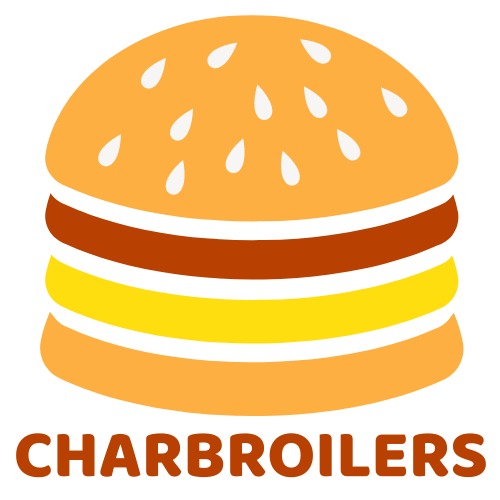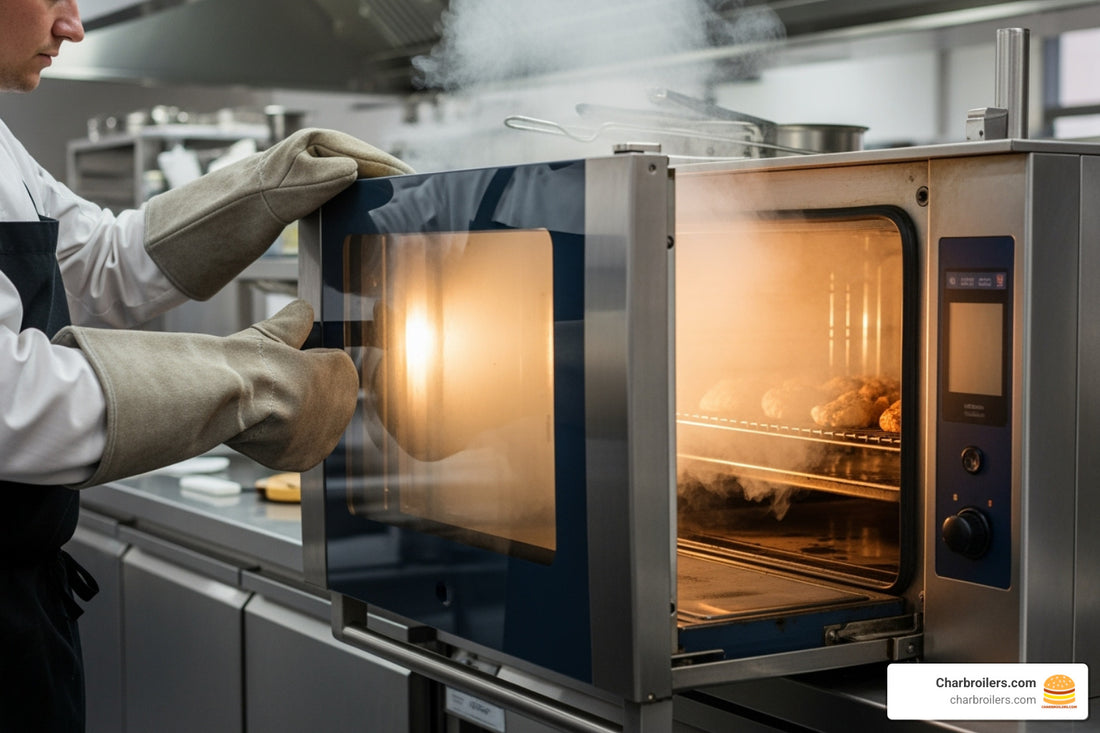
Don't Get Burned—Follow These Convection Oven Safety Guidelines
Share
Why Convection Oven Safety Matters in Your Commercial Kitchen
Convection oven safety tips are essential for protecting your staff and business from serious accidents and costly downtime. These powerful appliances cook food about 25% faster than conventional ovens, but they also present unique risks that require careful attention.
Essential Convection Oven Safety Guidelines:
- Always use oven mitts when handling hot pans and racks
- Turn off the fan before removing pans to prevent burns from hot air circulation
- Load pans from bottom up and center them on racks for proper airflow
- Wipe up spills immediately to prevent them from baking onto surfaces
- Never overload the oven or use deformed pans that block air circulation
- Allow proper cooling time before cleaning and always follow lockout/tagout procedures
- Check door seals regularly to ensure heat doesn't escape
- Keep electrical components away from water during cleaning
The stakes are high. Over 60% of warranty service calls stem from improper installation alone. Factoring in daily risks like burns and grease fires, it's clear why systematic safety protocols are crucial.
Proper safety practices also extend equipment life and maintain cooking consistency, ensuring the even heat and faster cooking times your kitchen depends on.
I'm Sean Kearney from Charbroilers.com, and over my decade in the restaurant equipment industry, I've seen how proper convection oven safety tips can prevent costly accidents and keep kitchens running smoothly. My experience helping restaurants find reliable equipment has taught me that safety isn't just about following rules - it's about building habits that protect your investment and your people.
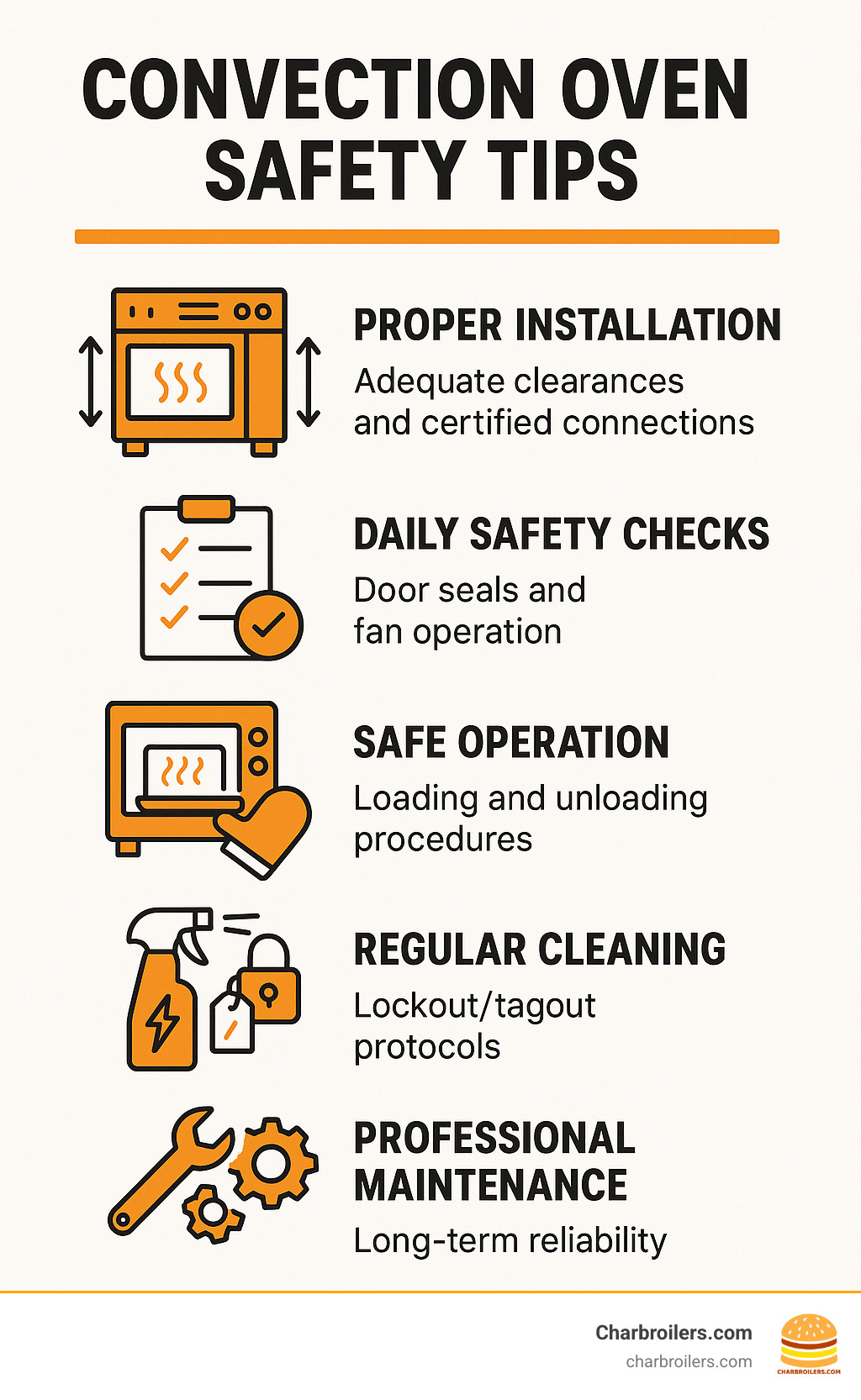
Convection oven safety tips definitions:
Setting the Stage for Safety: Proper Installation and Placement
Proper installation is the foundation of convection oven safety. These crucial convection oven safety tips start before you even plug in your new equipment.
Over 60% of warranty service calls stem from improper installation. This isn't just an expensive headache; it's a safety risk that can lead to electrical fires, gas leaks, and poor performance.
Proper installation is your first line of defense. A correctly installed oven maintains stable temperatures, operates efficiently, and avoids stress on its components, protecting your investment and your team.
Ensuring Proper Ventilation and Clearances
Your convection oven generates serious heat, and without proper breathing room, that heat becomes your enemy. I've seen too many kitchens where equipment was crammed together like sardines, only to deal with warped surfaces, damaged neighboring equipment, and even fire risks down the line.
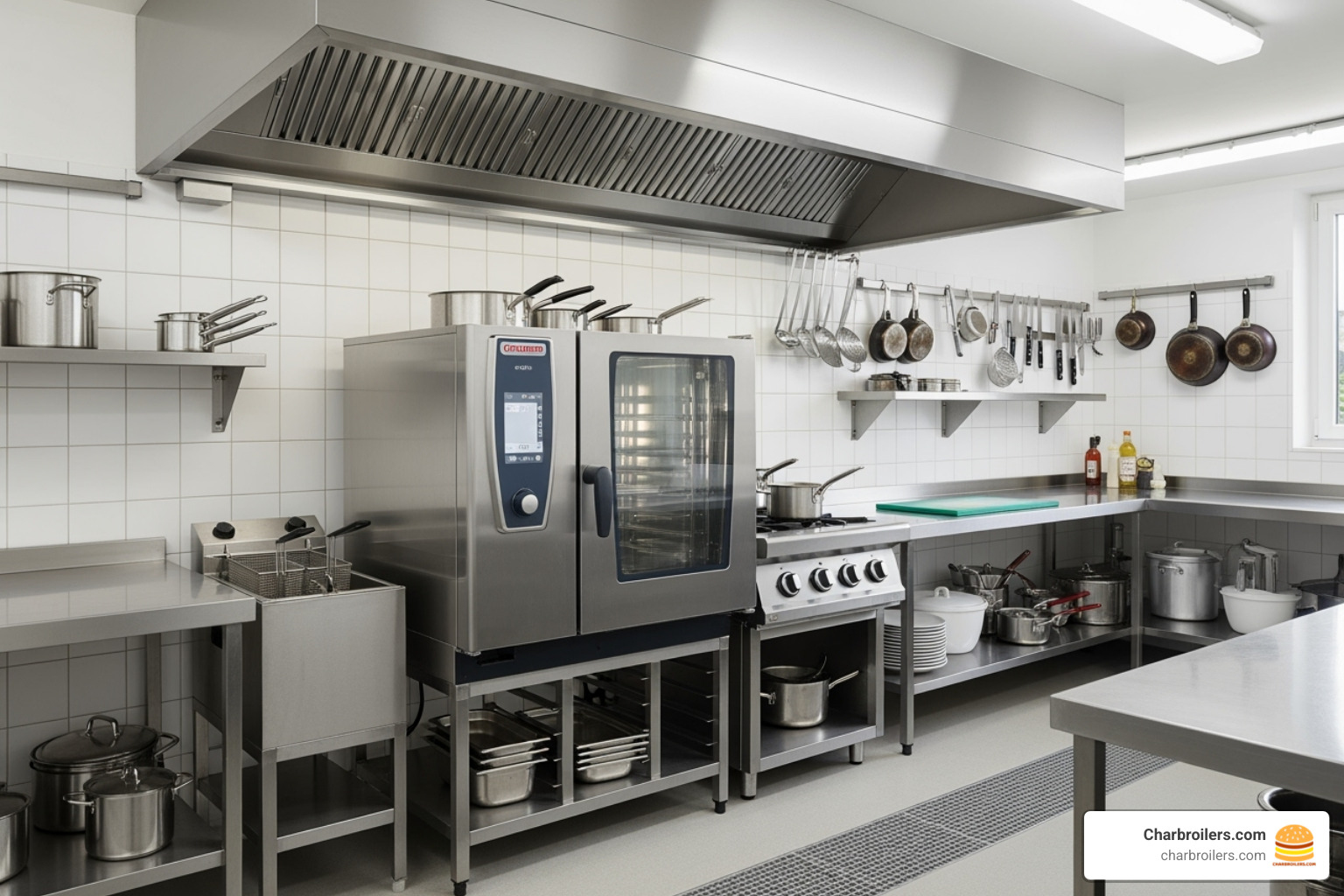
Airflow is absolutely critical for your oven's safety and performance. Without proper ventilation, your equipment will overheat, leading to component failures and inconsistent cooking results. Your oven needs space to breathe - it's not being dramatic, it's physics.
Always check your manufacturer's clearance guidelines before installation. These aren't suggestions you can ignore when space gets tight. Most industrial ovens need at least 4 inches from walls and 11 inches from the ceiling. These numbers exist for good reason.
Keep flammable materials far away from your oven. This includes obvious things like paper products and cleaning chemicals, but also consider food packaging and other items that might accidentally end up too close to your equipment.
Most commercial convection ovens require a robust exhaust hood system to safely remove heat, smoke, and cooking fumes. This isn't just about comfort - it's about preventing the buildup of potentially dangerous vapors. If you're curious about alternatives, check out our guide on Ventless Commercial Convection Ovens That'll Blow You Away Without The Vent.
Electrical and Gas Connection Safety
Here's where I need to be completely clear: electrical and gas connections are not DIY projects. Unless you're a certified technician, step away from the toolbox and call in the professionals.
Certified technicians understand the specifics your oven needs - whether it's 220V for smaller units or 380V for larger industrial models. They know how to ensure proper grounding and can spot potential issues before they become dangerous problems.
Your oven needs a dedicated, grounded electrical outlet. Sharing circuits or using extension cords isn't just against code - it's a fire hazard waiting to happen. Overloaded circuits cause electrical fires, and that's not a risk worth taking.
For gas models, a qualified technician will inspect gas lines for leaks and ensure shutoff valves are easily accessible. Gas leaks are serious business, and proper installation is your best protection against them.
Cord management might seem minor, but it matters. Keep power cords away from heat sources, sharp edges, and high-traffic areas where they could be damaged or cause someone to trip. Never move your oven by pulling on the power cord - that's a recipe for expensive repairs.
Water and electricity don't mix, ever. Keep your oven's electrical components dry, especially during cleaning. If liquid contacts electrical parts, disconnect power immediately and have a technician inspect the unit before using it again.
Finally, make sure your oven sits on a level, stable surface. A wobbly oven isn't just annoying - it's dangerous. Hot contents could spill, or in extreme cases, the unit could tip over.
Safety starts before you even turn on the heat. For more insights on overall kitchen design and equipment placement, take a look at our guide on kitchen design.
Mastering Day-to-Day Use: Essential Convection Oven Safety Tips
With your oven installed, focus on daily habits for safety and efficiency. This is where most accidents happen, but with the right convection oven safety tips and consistent routines, safe operation becomes second nature.
Daily operation is like driving: procedures become automatic, but complacency is dangerous. Every time the oven door opens, staff must consider PPE, proper techniques, and potential hazards.
Safe Preheating and Loading: More Convection Oven Safety Tips
Preheating might seem like the simplest part of using your oven, but it's actually where many safety protocols begin. Getting this right sets you up for success throughout the entire cooking process.
Start with your oven's manual – I know, I know, nobody likes reading manuals, but every convection oven has its own personality. Some have auto-conversion features that adjust temperatures for you, while others require manual adjustments.
Remember the 25°F rule when setting your temperature. Convection ovens cook about 25% faster than regular ovens, so you'll typically want to lower your recipe temperature by 25°F. This isn't just about cooking quality – it prevents overcooking that can lead to smoke and potential fire hazards.
Wait for the preheat signal before loading food. Rushing this step can result in uneven cooking and the temptation to open the door repeatedly to check progress, which wastes energy and creates safety risks from repeated exposure to hot air blasts.
When it's time to load your oven, heat-resistant oven mitts are absolutely non-negotiable. I've seen too many burns from people thinking they can quickly slide a pan in without protection. The oven interior, racks, and door are all extremely hot surfaces waiting to cause injury.
Turn off the fan before opening the door if your oven allows it. That circulating hot air can create a sudden blast of heat that catches people off guard. It's like opening a car door on a windy day – except the wind is 400°F.
Load from bottom to top when using multiple racks. This prevents spills from dripping onto lower pans and makes the loading process more organized and safer. Center your pans on the racks to ensure proper air circulation – this is what makes convection cooking so effective.
Never overload your oven. Beyond blocking the crucial airflow that makes convection work, overloading makes it dangerous and difficult to remove pans safely. Your staff shouldn't have to play Jenga with hot cookware.
For detailed operating procedures, including specific preheating and fan operation guidelines, check out this comprehensive resource: Cooking Equipment: CONVECTION OVENS.
Choosing the Right Cookware and Avoiding Hazards
The pans and cookware you choose can make the difference between safe, efficient cooking and a potential disaster. It's not just about what fits in the oven – it's about what works safely with convection technology.
Use properly sized pans that can contain your food without risk of boiling over. Spills don't just make a mess – they bake onto the oven interior, creating smoke, odors, and potential fire hazards during future cooking cycles.
Never use warped or deformed pans. These unstable pieces of cookware can rock, spill, or even get stuck in the oven. I've seen kitchen staff struggle to remove a stuck pan from a hot oven – it's dangerous and completely avoidable.
Be extremely cautious with aluminum foil. While it might seem convenient, foil can block the airflow that makes convection ovens work. Even worse, loose pieces can get sucked into the fan or reflect heat in ways that damage the oven's interior. When in doubt, skip the foil entirely.
Choose low-sided pans and rimless baking sheets whenever possible. High-sided cookware blocks the air circulation that's essential for convection cooking. Think of it this way – your oven is trying to blow hot air around your food, so don't build walls that block it.
Safe cookware materials include metal baking sheets and roasting pans, ceramic dishes, oven-safe glass bakeware, and high-temperature silicone. Avoid plastic containers unless they're specifically rated for high oven temperatures, and never use wax paper unless it's completely covered by food and won't be exposed to direct heat.
Safe Unloading and Shutdown Procedures
The cooking might be done, but your safety protocols aren't. How you remove food and shut down your oven can prevent burns, equipment damage, and even fires.
Those heat-resistant oven mitts are just as important coming out as going in. The oven interior, racks, and pans are all at peak temperature when cooking is complete. Don't get careless just because you're almost done.
Turn the fan off before opening the door to remove food. This prevents that blast of hot air and makes pan removal much safer and more controlled.
Use both hands and maintain a steady grip when removing pans. If something feels stuck or unbalanced, close the door, take a breath, and reassess. Rushing this step is how accidents happen.
Turn the temperature to zero and power off the unit when you're finished cooking. Don't assume the oven will safely cool down on its own – take control of the shutdown process.
Every kitchen needs a clear emergency shutdown procedure. If you notice smoke, fire, or unusual sounds from the oven, immediately turn off the power and gas (if applicable). For fires, use a Class K fire extinguisher designed for kitchen fires, or evacuate and call emergency services if the situation is beyond your control. Make sure every team member knows these procedures – safety training isn't optional in commercial kitchens.
These convection oven safety tips might seem like a lot to remember at first, but they quickly become routine. The key is consistency – make these procedures standard operating procedure for everyone who uses the oven, and you'll create a safer, more efficient kitchen for everyone.
Critical Cleaning and Maintenance: Long-Term Convection Oven Safety Tips
Think of cleaning and maintenance as your insurance policy against kitchen disasters. I've seen too many restaurants learn this lesson the hard way – a grease fire that could have been prevented, or a breakdown during the dinner rush that traces back to skipped maintenance. Convection oven safety tips aren't just about daily operation; they're about building habits that protect your investment for years to come.
Grease buildup is your biggest enemy here. That innocent-looking film on your oven walls becomes a serious fire hazard when it accumulates over time. Beyond the safety risks, neglected maintenance kills efficiency and leads to those expensive service calls that always seem to happen at the worst possible moment.
The good news? Most problems are completely preventable with consistent care and attention to detail.
Step-by-Step Safe Cleaning Procedures
Cleaning your convection oven safely is about more than making it sparkle – you're removing fire hazards and ensuring every component can do its job properly.
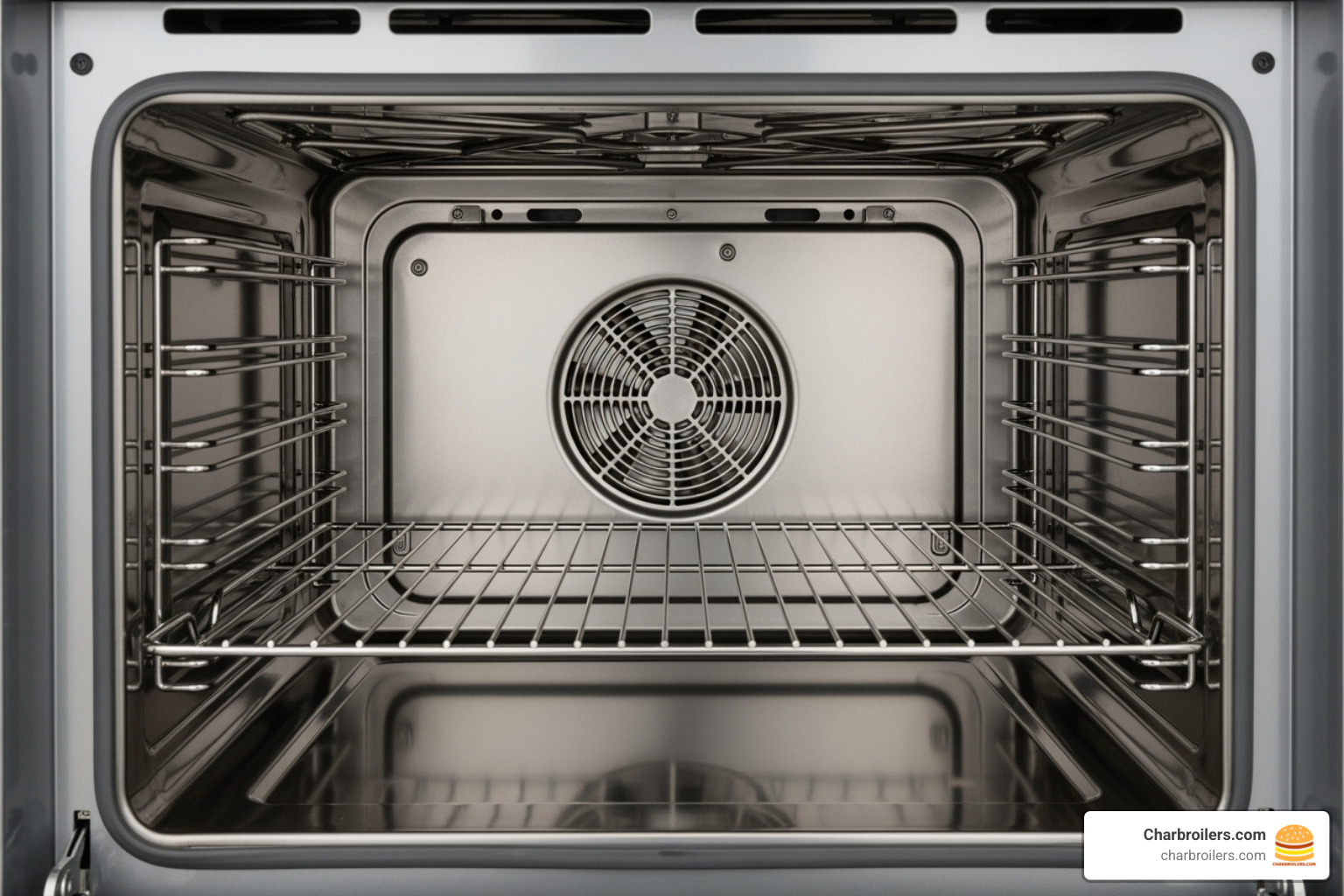
Start with patience. Never rush into cleaning a hot oven – it's a recipe for burns and ineffective cleaning. Allow your oven to cool completely to room temperature. If you're in a hurry, crack the door open slightly to speed up cooling, but resist the temptation to start early.
Follow lockout/tagout procedures before any serious cleaning session. This isn't bureaucratic red tape; it's your protection against accidental startup while your hands are inside the oven. Turn off the power, disconnect the unit if possible, and tag it clearly so no one else tries to use it.
Remove everything that comes out easily – racks, fan guards, drip trays, and any other removable components. These parts get the VIP treatment: a nice soak in warm, soapy water while you tackle the main chamber. This makes your job easier and ensures thorough cleaning.
Clean the interior systematically. Use a mild detergent and warm water solution with a non-abrasive cloth or sponge. Pay special attention to the area around the fan and heating elements where grease loves to hide. For stubborn buildup, a non-metallic scouring pad works wonders without damaging surfaces.
Be extra careful around electrical components – water and electricity don't mix well. Avoid dripping water onto internal wiring or control panels.
The exterior deserves attention too. Wipe down all external surfaces with a damp cloth and mild detergent. A clean exterior isn't just about appearances – it prevents buildup that can interfere with ventilation.
Stick to approved cleaning agents designed for oven use. Harsh chemicals might seem more effective, but they can damage surfaces and leave dangerous residues. Never use pressure washers or spray cleaners that can force water into electrical components.
Rinse thoroughly and let everything dry completely before reassembling. Trapped moisture can cause electrical problems and create perfect conditions for bacteria growth.
Routine Maintenance Checks for Key Components
Regular maintenance checks are like taking your oven's pulse – they help you catch problems before they become emergencies. I've organized these by frequency because consistency matters more than perfection.
Daily maintenance focuses on immediate fire prevention. Wipe up spills right away before they bake on and become harder to remove. Remove large food debris with a brush or scraper, and give interior surfaces a quick wipe with a damp cloth. Don't forget the exterior – a clean oven is a safer oven.
Weekly checks dig a little deeper into system health. Inspect your fan motor and exhaust system for debris or blockages that could restrict airflow. Clean air intake vents thoroughly, and examine door gaskets for cracks or damage. These seals are crucial for maintaining proper temperature and preventing heat from escaping to dangerous areas.
Monthly maintenance addresses the mechanical side of things. Check for loose screws or bolts that vibration might have worked free. Lubricate door hinges and other moving parts with food-grade, high-temperature lubricant. Test your thermostat accuracy with a calibrated oven thermometer – temperature control problems often start small and grow into major issues.
Annual professional inspections are non-negotiable. A qualified technician can spot problems you might miss and perform maintenance that requires specialized knowledge. This includes comprehensive checks of electrical components, heating elements, gas lines, and safety features.
Your door gaskets and seals deserve special attention because they're working hard every day. Damaged seals don't just waste energy – they allow heat to escape, making external surfaces dangerously hot and forcing your oven to work harder.
Fan blades and vents are the heart of convection cooking. Keep them clean and ensure they move freely. Blocked vents or grease-covered blades don't just affect cooking quality – they can cause overheating and create fire risks.
Thermostat calibration might seem technical, but it's straightforward to check. Place a reliable oven thermometer inside your preheated oven and compare readings. If there's a significant difference, call for professional calibration rather than guessing at temperature adjustments.
Understanding Lockout/Tagout (LOTO)
Lockout/Tagout might sound like industrial jargon, but it's a simple concept that saves lives. LOTO prevents equipment from starting up unexpectedly while someone is working on it – imagine reaching into your oven to clean the fan just as someone else tries to turn it on.
The process is straightforward: physically disconnect or lock the power source, then attach a clear warning tag explaining that maintenance is in progress. This protects both the person doing the work and prevents others from accidentally energizing dangerous equipment.
Use LOTO procedures whenever you're doing anything beyond basic surface cleaning – especially when working with internal components, electrical connections, or gas lines. The few extra minutes it takes could prevent a serious injury.
Training your entire staff on LOTO procedures creates a culture of safety that extends far beyond oven maintenance. When everyone understands these principles, your whole kitchen becomes a safer place to work.
These convection oven safety tips for cleaning and maintenance aren't just suggestions – they're the foundation of a safe, efficient kitchen that serves you well for years to come.
Frequently Asked Questions about Convection Oven Safety
Even with the best convection oven safety tips in mind, questions can pop up. We get it! It's natural to wonder about the specifics when you're working with such powerful equipment. So, we've gathered some of the most common safety questions our customers ask and laid out the answers clearly for you.
What Personal Protective Equipment (PPE) is necessary for operating a convection oven?
When you're working with a hot convection oven, keeping yourself safe is paramount. Your hands and arms are often closest to the heat, so heat-resistant oven mitts or gloves are your absolute best friends. Always wear them when you're reaching into the oven, handling hot pans, or even just opening the door. They create a vital barrier between your skin and those high temperatures.
Now, when it comes to cleaning, you might be using some strong stuff to cut through grease and grime. That's where safety goggles and chemical-resistant gloves come in handy. These protect your eyes from splashes and your skin from any harsh cleaning agents. Think of PPE as your personal safety shield – always wear it!
How do I know if my convection oven's thermostat is accurate?
An accurate thermostat is super important for both food safety and getting perfect results every time. If your oven's temperature is off, your food might be undercooked (a food safety no-no!) or even overcooked.
So, how can you check? It's pretty simple! Grab a reliable, calibrated oven thermometer and place it inside your convection oven. Preheat the oven to a specific temperature, like 350°F (175°C), and let it run for about 15-20 minutes. This gives the oven time to reach and stabilize its temperature. Then, compare what your oven's display says to the reading on your external thermometer.
If there's a big difference – say, more than 10-15°F – that's a red flag. It means your oven's thermostat might be off. If that's the case, it’s best to call a qualified technician to recalibrate or replace it. Don't try to guess your way through cooking; accuracy keeps your kitchen running smoothly and safely!
What are the most common signs of a safety issue with a convection oven?
Your convection oven usually gives you hints if something's not quite right. Being observant and knowing what to look for can prevent a small issue from becoming a big problem.
First, listen up! Unusual noises like grinding, rattling, or a loud humming from the fan, especially if it’s new, can signal a problem with the motor or something caught inside. For gas models, any distinct smell of gas is an immediate emergency. Turn off the oven, shut off the gas supply, air out the area, and call a professional technician right away. Don't wait!
Then, pay attention to your food. Inconsistent cooking results – like food burning on the outside but still raw inside, or uneven browning – can point to a faulty thermostat, a fan issue, or problems with air circulation. If your oven door isn't closing tightly, or you see steam escaping, your door seals might be damaged. This not only wastes energy and makes your kitchen hotter, but it also means the oven's exterior could get dangerously hot.
Finally, if your oven is taking forever to heat up, or simply fails to heat up at all, it could be a sign of an electrical problem or a heating element issue. And of course, smoke or a burning smell that isn't from your food (think electrical burning, not just a little char) means something serious is happening, like grease buildup or an electrical fault.
Whenever you notice any of these signs, don't ignore them. Power down your unit (both electrical and gas, if applicable) and immediately call a professional service technician. Trying to fix complex issues yourself can be dangerous and costly. When it comes to convection oven safety tips, recognizing these warning signs is one of the most important!
Conclusion
Safety isn't just another item on your kitchen checklist - it's the foundation that everything else is built on. When you implement proper convection oven safety tips, you're creating a workplace where your team can focus on what they do best: creating amazing food without worrying about preventable accidents.
Think of it this way: every time you follow these safety protocols, you're making an investment. You're investing in your equipment's longevity, your staff's wellbeing, and your business's reputation. It's one of those rare situations where doing the right thing also happens to be the smart business move.
We've walked through the four essential pillars that keep your convection oven operation running safely. Proper installation sets you up for success from day one, preventing the majority of issues that lead to service calls and safety hazards. Safe daily operation becomes second nature when your team understands the why behind each step - from preheating procedures to the critical importance of using oven mitts every single time.
Regular cleaning might seem like a chore, but it's your best defense against grease fires and equipment breakdowns. And proactive maintenance catches small problems before they become expensive emergencies that shut down your kitchen during the dinner rush.
The beauty of building a safety-first culture is that it becomes self-reinforcing. When everyone on your team understands these convection oven safety tips and sees their value in action, safety stops being something you have to enforce and starts being something everyone naturally does.
At Charbroilers.com, we've seen how the right equipment paired with proper safety knowledge transforms kitchens. We're not just here to sell you equipment - we're here to help you succeed safely and profitably.
Ready to upgrade your convection oven setup? Check out our comprehensive The Ultimate Guide to Comparing Commercial Convection Ovens to find the perfect fit for your kitchen's needs and safety requirements.
